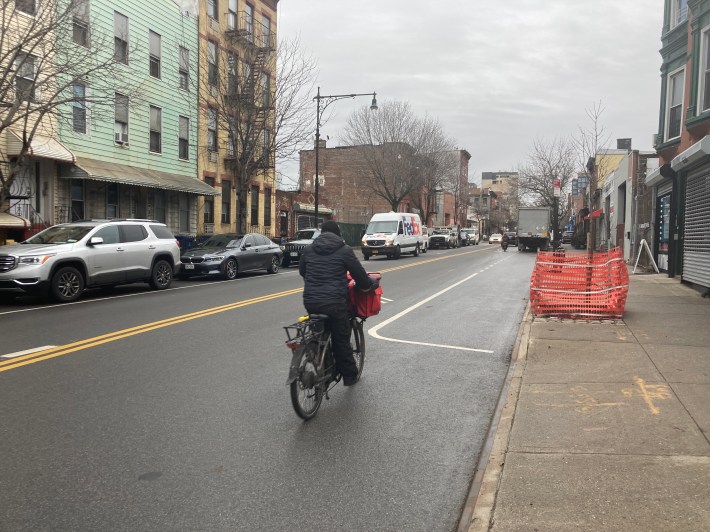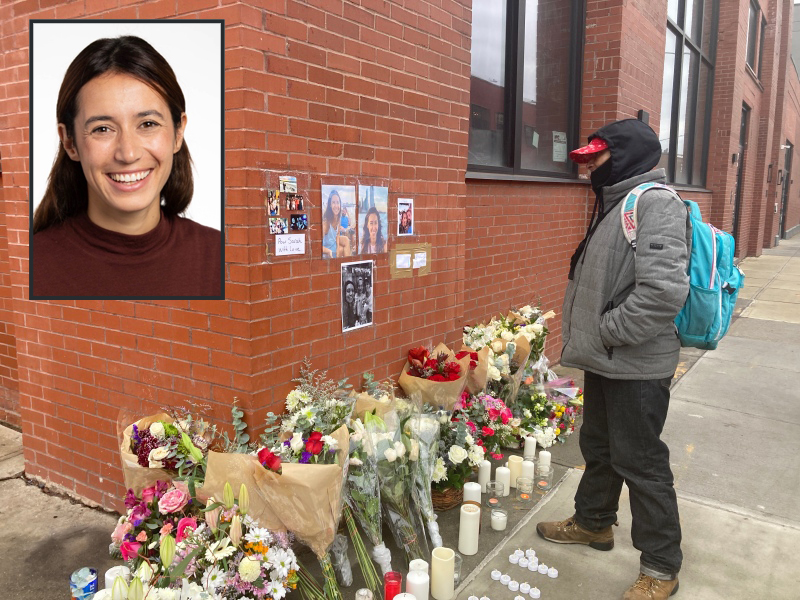Cyclists vented their anger at unsafe conditions on Brooklyn’s Ninth Street bike lane on Thursday, two days after a truck driver killed a 37-year-old wife and mother of two while she was riding an electric Citi Bike on an unprotected stretch west of Third Avenue, the spot marked as always by illegally parked cars and trucks and, now, flowers and candles laid out on the corner in memory of the victim, 37-year-old Sarah Schick.
Near the memorial on Thursday, one woman on a Citi Bike on her way from Red Hook to Bedford-Stuyvesant told Streetsblog that she wished the city would do more to keep people on two wheels safe, especially in more truck-heavy areas like where Schick was killed. Ninth Street has a protected bike lane between Prospect Park and Third Avenue, but west of Third Avenue, it becomes an unprotected lane in an industrial zone.
“It’s pretty scary most of the time. There’s a lot of trucks in the bike lane and cars just going fast,” said Emily Cowan. “Ninth Street is great because it’s protected for so long, but then the second it gets unprotected there's a lot of industrial traffic, which doesn't feel great.”
Schick died on Tuesday morning after she was overtaken and run over by the 39-year-old driver of a 2022 Freightliner box truck in the very same spot as she headed east on Ninth Street near Second Avenue.
Schick died on the scene, according to police, who have not issued any summonses, though the investigation is ongoing.
Another biker on her way to an area pharmacy hopped the curb to ride on the sidewalk to get out of the way of a truck that was in the bike lane.
She was asked if she feels safe on her bike.
“No, when you ride the bike and people park the cars along the side,” said Elizabeth, who declined to give her last name.
Sarah Schick was run over and killed by a box truck driver on 9th Street b/c this town simply does not care. It could have been me. @CMShahanaHanif is committed to push @NYC_DOT. Are you too, @CMBrooksPowers ? https://t.co/r4GWnSndB1 https://t.co/OJv7EmSBbY
— Radlerkönigin (@radlerkoenigin) January 12, 2023
And Frank Iozzio, who rides the same route on Ninth Street so often that he saw Schick’s lifeless body on the pavement that day, believes the city can make a difference if it wants.
“It sat with me all week. It’s so sad it breaks my heart,” said Iozzi. “It’s so avoidable.”
As avoidable as it is, the city has done little to address it, fed-up advocates charge. The Department of Transportation knew about the dangerous portion of Ninth Street long before Schick was killed.
In 2003, the city hired Arup Engineering to study how to make Downtown Brooklyn, including portions of Ninth Street, safer and less of a traffic sewer. The firm pointed to specific solutions like sidewalk extensions, neckdowns, and a reprogramming of traffic lights. But none of it happened.
One year after the study came out, 11-year-old Victor Flores and 10-year-old Juan Angel Estrada were killed by a trucker on Ninth Street at Third Avenue on their way home from school. But still, no improvements were made.
And then 14 years later in 2018, driver Dorothy Bruns hit and killed 1-year-old Joshua Lew and 4-year-old Abigail Blumenstein after suffering a seizure while behind the wheel. Blumenstein’s mother, actress Ruthie Ann Miles was injured in the crash and lost her unborn child. Bruns later died by suicide.
This part of 9th St is 36' wide. Plenty of room for protected #bikeNYC lanes. @NYC_DOT just has to decide that lives are more important than parking and turn lanes. https://t.co/gN8IFEHbqa pic.twitter.com/AFSujdqh72
— BrandonWC (@BrandonWC) January 12, 2023
Months after the tragic crash, the city did redesign Ninth Street, by installing a protected bike lane and pedestrian islands — but only east of Third Avenue, stopping short of where Flores and Estrada and now Schick were killed.
According to Aaron Naparstek, a street safety activist and co-host of the “War on Cars” podcast, the DOT told him and three other advocates during a meeting that year that they weren’t going to make the area west of Third Avenue safer because it had “less conflict” as a result of more commercial and less residential buildings.
“It seemed really arbitrary stopping at Third Avenue. It didn’t make sense to us. Here’s the result of your unnecessary compromise — four-and-a-half years later, a woman is killed on this stretch of Ninth Street where the DOT could have easily extended the bike lane.”
Now, the city cannot afford to make the same mistake twice, and must utilize every option to save lives.
“I think DOT needs to look at every possible option in its tool kit,” said StreetsPAC’s Eric McClure.

A spokesperson for DOT told Streetsblog that the agency is reviewing the crash to explore safety enhancements, but that its “significantly narrower stretch” requires additional study. That section of Ninth Street is “narrow” because the curbside lane on both sides of the block between Third and Second avenues is set aside for the storage of parked cars. There, the bike lane turns into shared sharrows with cars.“Every life lost on city streets to traffic violence is an unconscionable tragedy. The investigation for yesterday’s crash remains ongoing, and DOT will review street design at the location as we do for every crash,” said the spokesperson, citing the city’s nearly $1-billion investment in street redesign and enhancement of more than 1,400 intersections last year.
“But we can and will do more. Our thoughts are with the victim’s loved ones as we grieve individually and collectively for those killed on our roads.”
"[W]est of Third Avenue, where there is considerable truck traffic, neither side has a bike lane at all — a decision made by the Department of Transportation to preserve a small number of parking spaces." NYC priorities: Parking over people. https://t.co/ELsRqtbmQ7
— Sarah Goodyear (@buttermilk1) January 11, 2023






